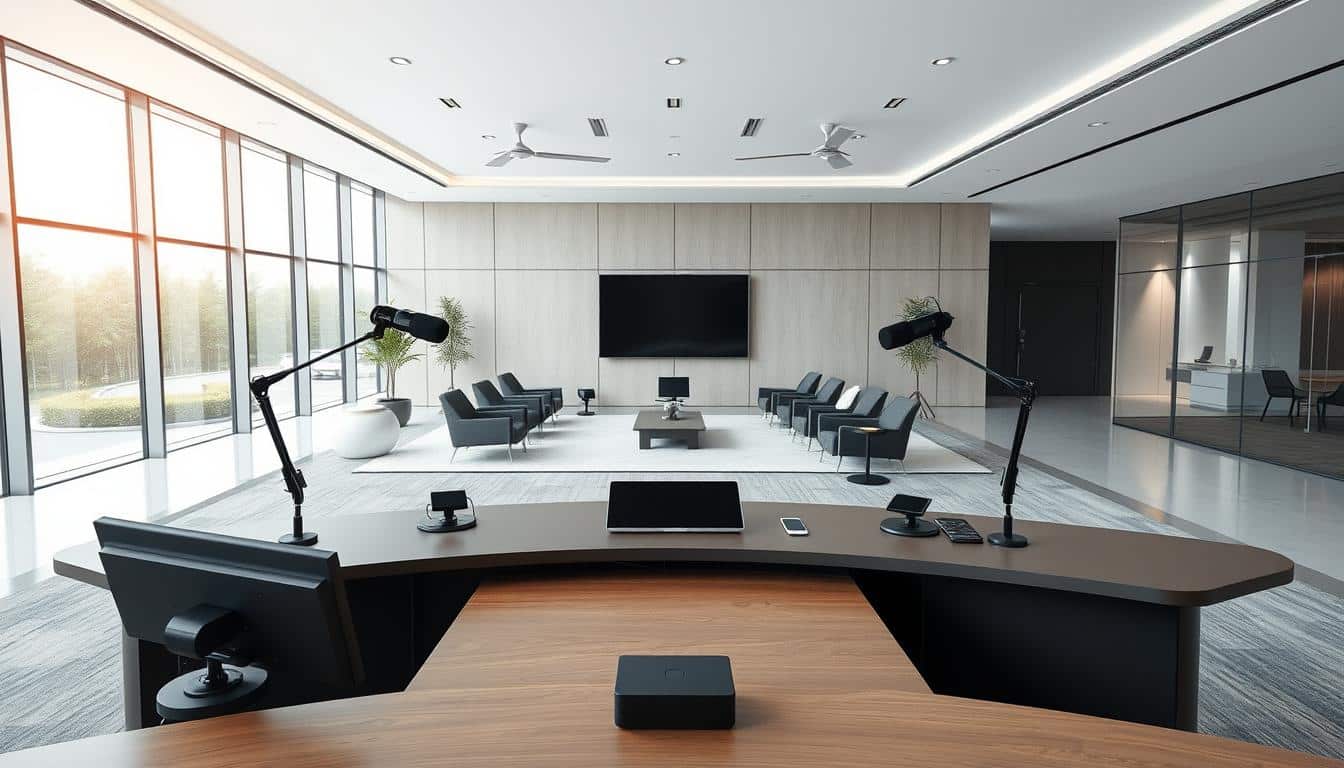Anúncios
In our fast-moving world, being skilled at virtual meetings is key to good remote communication. As work shifts to online and mixed environments, knowing how to improve your virtual presence is important. This guide gives tips to make online meetings better, promote teamwork, and keep a professional atmosphere.
Getting ready is crucial; talk to teammates or classmates before meetings, know what will be discussed, and have everything you need. How you look matters too, even online. Wearing the right clothes and having a tidy, bright place to sit can change how others see you. Also, being clear and deliberate when you talk is vital, as it’s easy to misunderstand tone and gestures online.
Anúncios
Start with casual chat to warm up and make everyone feel more together. This helps make the online meeting space feel friendlier and more engaging.
The Importance of Professionalism in Virtual Meetings
We now meet and work with others online much more than before. Companies like Connex Intl have created hybrid ways of working to be more flexible. However, this change has brought new challenges. Keeping up good communication and acting professionally online are key for doing well. A big number of workers agree that how you behave really matters. It affects teamwork and how much gets done in these online meetings.
Anúncios
Understanding the Shift to Virtual Communication
Most people, about 90%, think wearing a baseball hat during video calls is not okay. It shows how what you wear matters for looking professional online. On top of that, 68% feel dressing right affects how skilled others think you are. While many, 77%, treat online meetings like regular ones, a few, 16%, don’t take them as seriously. This highlights the ongoing need to pay attention to how we come across professionally.
Impact on Collaboration and Productivity
Technical difficulties are a big distraction for 72% of users. Noise in the background also bothers 57% of people in online meetings. Being able to take part well is crucial, with 45% saying it’s a major issue. Wrapping up meetings with a summary helps keep things clear. Also, 56% find these summaries useful for remembering what needs to be done.
Tips for Virtual Meeting Professionalism
Joining virtual meetings means paying close attention to your look and acting professionally. Dressing well is key to doing well. It shows you take yourself and the meeting seriously. It also shows respect for your coworkers and the meeting’s aim. Making sure everyone feels respected is key too. This helps everyone discuss things effectively. Here are some smart ways to keep it professional in online meetings.
Dressing Appropriately for Success
What you wear is super important in online meetings. Dressing right shows you mean business and sets the discussion’s mood. Keep these tips in mind:
- Choose clothing that aligns with the company’s dress code.
- Avoid overly casual attire to maintain a polished appearance.
- Ensure your appearance is tidy, including hair and grooming.
Choosing the right clothes boosts your professional image. It also makes you feel more confident and involved in the meeting.
Creating a Respectful Environment
For successful online meetings, a respectful setting is key. Make a setup that helps you stay focused. Follow these good habits:
- Mute your microphone when not speaking to avoid interruptions.
- Make eye contact with the camera to show you’re paying attention.
- Listen well and respect each person speaking.
- Encourage everyone to take part, so no one feels left out.
This approach helps everyone work well together. Ideas get shared more easily. Dressing well and showing respect helps meet goals well.
Setting Up Your Virtual Meeting Space
A well-set-up virtual meeting space boosts your professionalism online. Good camera placement, lighting, and a simple background help. They make the meeting clearer and more engaging for people watching. Setting up your space well really changes how others receive your message.
Optimal Camera Positioning and Lighting
It’s important to place your camera right to keep eye contact and look natural on screen. Put your webcam at eye level for a personal touch. Use a stable laptop or desktop, and maybe get a Logitech C922 for better video quality.
For better light, consider LED lamps or daylight bulbs. They reduce shadows and evenly light your face. This makes everything look clearer.
Choosing a Neutral Background
The background affects how professional you seem. Choose something simple that doesn’t distract viewers. A clean, organized space shows you’re serious about your online meetings. Stay away from virtual backgrounds as they can be distracting.
By having a clean and straightforward setting, people focus more on what you’re saying. This helps your message stand out more.
Technical Preparations for a Flawless Meeting
For a successful virtual meeting, getting the tech right is crucial. It affects how professional and effective the meeting will be. Everyone will have a smoother experience if you check everything beforehand. Key things to have in order are a strong internet connection, good audio and video, and knowing how to use your conferencing tools.
Testing Your Internet Connection
Before your meeting starts, make sure your internet is reliable. It’s the most important part of any online meeting. You can use speed test tools to check your internet speed. Make sure it fits what your conferencing software needs. Getting on early helps you fix any issues before they disrupt your meeting.
Audio and Video Quality Checks
Clear audio and video are critical for everyone to understand each other. Make sure your camera and microphone work well. Keep the camera at your eye level for a professional look, and use headsets to block out noise. Also, make sure the room is well-lit without any shadows covering your face.
Familiarizing Yourself with Conferencing Tools
Knowing how your conferencing software works makes the meeting better for everyone. Learn about features like breakout rooms and screen sharing. This keeps people involved. Update your software before the meeting to get the latest functions. A test run with a friend can help you spot and fix issues early.
Scheduling Virtual Meetings Effectively
Effective scheduling is key to successful virtual meetings. Knowing when everyone can attend is crucial. Finding the best time helps the meeting go smoothly and boosts productivity.
Finding the Right Timing for Participants
Choosing the right time boosts participation. Try starting meetings a little after the hour. This gives everyone time to finish up earlier tasks and get ready.
Remember to consider everyone’s time zones. Being punctual shows respect for others’ time. Coming on time or early starts the meeting off well.
Sending Clear Invitations with Agenda
Clear invitations are very important. Always add a detailed agenda so everyone knows what to expect. Sharing the agenda early lets people prepare, leading to better talks.
Use tools that allow sharing screens to keep everyone engaged. Summing up the meeting and outlining next steps keeps everyone on track.
Managing Audio During Virtual Meetings
Handling audio well is key to keeping virtual meetings professional. It’s important for everyone to mute and unmute at the right times. This reduces disruptions from background sounds. By doing this, we make the meeting better for all.
When and How to Mute
Muting yourself when you’re not talking helps keep things focused. Here’s how to manage your mute button:
- Always mute yourself in loud places to stop background noise from bothering others.
- Show you want to talk by doing something like raising your hand. This makes conversations flow better.
- Practice with the mute controls before meetings so you can use them without trouble.
Avoiding Background Noise
Cutting down on background noise makes everyone sound more professional. Here’s how you can do it:
- Use a top-quality microphone, like the Shure MV7+, for clearer voice capture without unwanted sounds.
- Keep your microphone close, but not too close — about 6 to 12 inches from your mouth is best.
- Wearing over-ear headphones helps keep the sound clear and stops feedback during talks.
- Set your audio right in Zoom or similar before meetings. Pick the best devices for sound in and out.
- Do a sound check with the built-in tools to make sure everything’s working fine.
Engaging Participants During Virtual Meetings
Making virtual meetings work well needs everyone to try hard. For a successful meeting, attendees must take part actively. Strategies that work well can make the meeting better for everyone. Asking questions and sharing feedback helps. It brings everyone’s ideas together, building trust and teamwork.
Encouraging Questions and Feedback
It’s good to make a space where everyone feels okay asking questions. Use easy tech and ask people to mute when not talking to lower noise. Starting with fun icebreakers, like sharing photos of workspaces, helps everyone get along. Activities like these make meetings nicer and help everyone feel important.
Strategies for Keeping Attendees Focused
To keep people interested, use interactive methods. Tools like BoardThing and Linoit are great for brainstorming and making choices together. These help keep everyone’s attention and let them share ideas during the meeting. Giving people specific roles, like leading the meeting or handling tech issues, helps keep things organized.
Always check your tech before the meeting to avoid problems. Think about having backup plans ready. Adding in quick stretch breaks or group activities can make the meeting more fun. Show important points with slides or documents. Using screen sharing, breakout rooms, and chat helps get everyone involved.
The Role of Body Language and Eye Contact
In virtual meetings, more than just words matter. Body language and eye contact are key to keeping people engaged. Studies show that 55% of how we communicate is non-verbal. This highlights the importance of noticing our subtle behaviors online. Improving our body language can make us seem more professional and connected.
Maintaining Engagement with Nonverbal Cues
To keep everyone’s attention, position yourself well. Sit straight, keep your shoulders relaxed, and don’t cross your arms to show confidence. Avoid behaviors like touching your face that might show you’re uneasy. Make sure your hands are in view and relaxed.
Looking into the camera helps simulate eye contact, creating trust and intimacy. Small actions, such as nodding and using words of agreement, show you’re actively listening. This makes the conversation feel more engaging and real.
How to Introduce Yourself Effectively
Starting off on the right foot is crucial. When you introduce yourself, share a short description of your role with your name. This helps others understand your place in the meeting and builds connections early. Keeping a good posture and smiling makes you more approachable.
Position your camera so it’s straight on, giving a clear view of your face. This encourages involvement and shows you’re a pro. Better non-verbal cues can lead to stronger first impressions in your online meetings.
Adhering to the Meeting Agenda
Following a structured meeting agenda boosts productivity in virtual meetings. It ensures discussions are focused, keeping everyone involved. By addressing all critical points, it respects time and encourages teamwork.
Staying on Track to Increase Productivity
Starting and ending meetings on time is key to maximizing productivity. It allows everyone to prepare and share their thoughts effectively. Here are tips to keep meetings efficient:
- Arrive a few minutes early to review meeting materials.
- Use the meeting agenda as a guiding tool throughout the discussion.
- Encourage concise contributions to minimize off-topic conversations.
Incorporating Breaks and Time Management
In long meetings, breaks are crucial for maintaining energy and focus. Allocating time for each topic helps manage the discussion. Sharing the agenda beforehand gets everyone ready to engage.
This approach respects everyone’s time, leading to structured and efficient discussions.

Conclusion
In our world today, being professional in online meetings is super important. Making sure everyone feels important and active is key. If we dress right, manage our mics, and use Notta for notes, meetings will be better for everyone.
Using tools like Bubbles can also make a big difference. It helps us talk less but do more, cutting down meeting time by 38%. Since we spend about 31 hours a month in meetings, following these rules is very important. It helps us stay professional and work better together.
To really do well in remote work, we need to mix good digital manners with the right language and meeting skills. Keeping up with these habits helps us feel sure in online meetings. It makes every meeting better and keeps up our professionalism.



